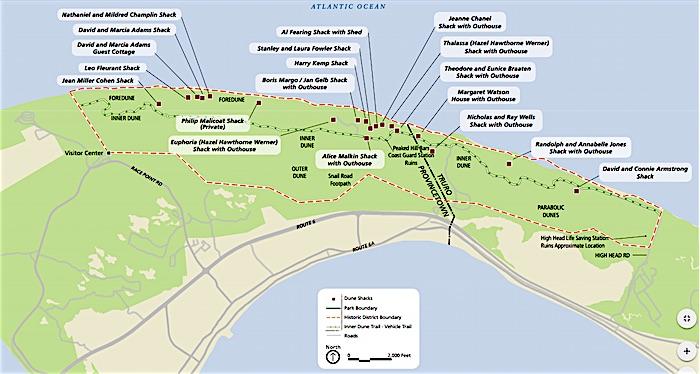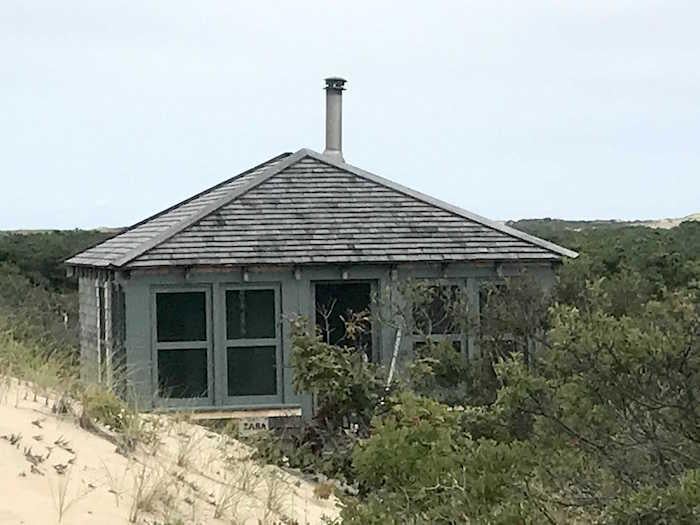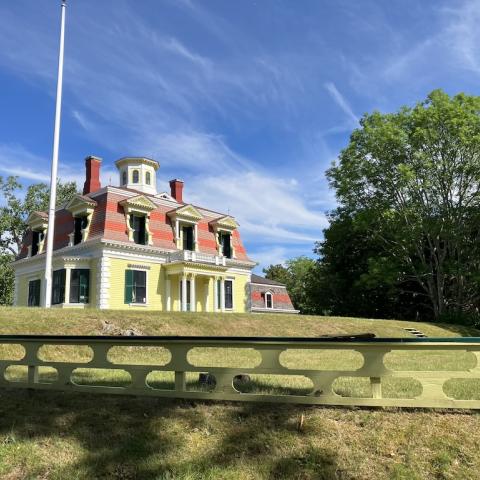
Dunes of Province Lands at Cape Cod National Seashore/Kurt Repanshek
Remnants of the past, of poets and artists who sought the stark inspiration offered by isolating, windswept dunes on the outer beaches of Cape Cod, stand weathered gray. Some appear wobbly and are almost hidden by their embracing dunes, while others stand atop the hills of sand with sweeping views out into the Atlantic.
This is a side of Cape Cod National Seashore without bike trails or greasy fried seafood stands, without an easily accessible beach for spending the day at. The pile of shoes and sandals at the trailhead sends a clear signal: this hike is best done barefoot. Your calves will let you know later that you've explored the Peak Hill Bars Historic District, for walking up and down dunes of sand is a chore in which every step slides and stretches your calf muscles.
As you weave through the dunes, the shacks that come into view leave you wondering who in their right mind would haul wood planks and furnishings out to this remote area to set up a hermit-like existence?

Creaky old dune shack at Cape Cod National Seashore/Kurt Repanshek
The 19 shacks that are sheltered within the historic district date to the early and mid-1900s, though the practice of living in the dunes dates to the late 1800s when similar shacks were built to house men (and sometimes their families) who toiled for the U.S. Life-Saving Service.
A successor to the Massachusetts Humane Society that was organized in 1785 to provide a rescue service for foundering ships and which erected small huts along the Massachusetts coastline to provide shelter for passengers and crew who managed to reach shore, the Life-Saving Service in 1878 was formally created by Congress. Stations popped up all along the U.S. coast; eventually there were outposts on the Great Lakes, along the Gulf Coast, and along the Pacific Coast. By the time the USLSS gave way to the U.S. Coast Guard in 1915, there were 279 stations in operation, and more than 177,000 lives had been saved.
In 2012, the Peaked Hill Bars area was added to the National Register of Historic Places. The qualifying merits of the 1,950-acre included the dune shack architecture; associations with art and literature; the life of poet Harry Kemp; potential archaeological resources; and the complex strands of maritime history, recreation, and the efforts of long-time dune shack dwellers who lovingly crafted homes amidst the shifting sands of the backshore of Truro and Provincetown.
Harry Kemp was also known as the "poet of the dunes." Kemp lived on and off in a shack in the dunes of Provincetown, Cape Cod for a period of about 40 years, and he died there in 1960. A 1934 Kemp poem titled, "The Last Return," was written for the Coast Guard men who steadfastly worked to save the lives of those shipwrecked on Cape Cod's coast. -- Wikipedia
Playwrite Eugene O'Neill took up summer residence in the original Peaked Hill Bars Life-Saving Station (built in 1872) after it was closed in 1918.
Today, 18 of the 19 shacks are owned by the National Park Service, which lets nonprofit groups utilize some of them. In applying for listing on the National Register of Historic Places, the Park Service turned to a local historian to document the significance of the collection of shacks.
Long-time dune dweller and historian Josephine Del Deo captured the philosophical approach to the traditions of the District as embodied in the physical shacks themselves. The dune shacks, she wrote, are “metaphorically speaking, almost an archeological resource, having been structures used at various periods for varying purposes: the several buildings of the Coast Guard Stations at Peaked Hill, a boat house, a half-way house to poet’s abodes, painters’ studios, naturalists’ lookouts, a home of essential spiritual retreat and rejuvenation for persons from every walk of life . . . these small, nameless abodes by their very simplicity serving to teach and retain for our society the first lesson of nature, the law of survival for all the creatures of the earth. Hundreds, perhaps thousands, have sought inspiration here, and many more will come to worship in these shelters of the human spirit.”
Some of the remaining shacks have intriguing histories, according to the Park Service. For instance:
* The Zara Malkin Ofsevit Shack featured "aluminum foil sheets on bedroom wall used to reflect lamp light";
* The Jeanne Chanel Shack was built in 1976 atop the original shack that dated to 1942; it features interior mural paintings;
* The Theodore and Eunice Braaten Shack that was built in 1931 is winterized and features "a sitting chair on roof ridge."
As we roamed the dunefields, we passed through patches of vegetation and were surprised when shacks popped up, both on top of dunes and at the bottom in hollows. Scrub pine, wild cherry, and beach plum grow here, as does bayberry, beach grass, scrub oak, cotton grass, and salt spray rose.

Roaming through this area of the national seashore can take you back, if you're imaginative, to the days before Route 6 was built down the cape in 1926 and greatly increased the human pressure on the landscape. For much of our hike we were alone with the breezes, birds, and waving vegetation. Trails you follow are those pounded into the sand by millions of visitors down through the decades. But you can venture off in just about any direction you want; just be careful around vegetation.
You can read more about the history of the shacks here and here.

A well-maintained dune shack at Cape Cod National Seashore/Kurt Repanshek
A visit to Peaked Hill Bars can take an hour or all day, depending on your mood and what you're in search of. Inspiration? A walk along the beach? A window into the past?


 Support Essential Coverage of Essential Places
Support Essential Coverage of Essential Places







Comments
My husband and I have been coming to the Cape for over 40 years. How we missed this amazing area and history of the Cape I don't know. It is just another example of the wonders and mysteries yet to be explored here. This so called small ever- changing peninsula captured our hearts so many years ago and never ceases to disappoint us.
Thanks for the rich and informative material. I hope to walk along the dunes one day and experience what those who spent time there once did.
A friend of ours has gone missing. He sometimes stays in the dune shacks at this time of year. Can someone pls tell us if he is there now? His name is Alan Petrulis. We want to rule this out before filing a missing person report. Thank you. [email protected]
A guy by that name posted something this month from NYC. I think he is OK.
Walked from Snail Road to the beach on a January morning and did not see a single person.
how do i get involved with helping with the dune shacks.